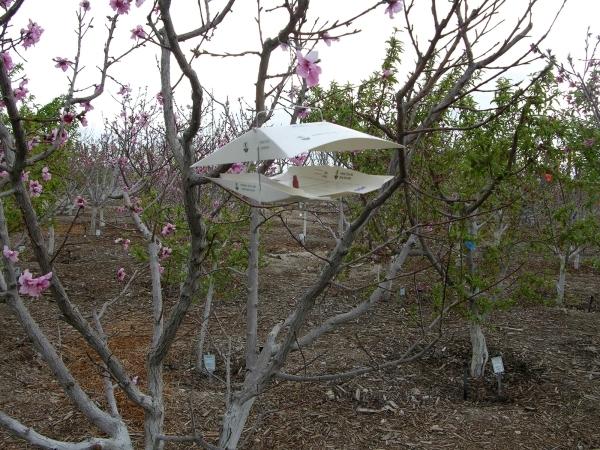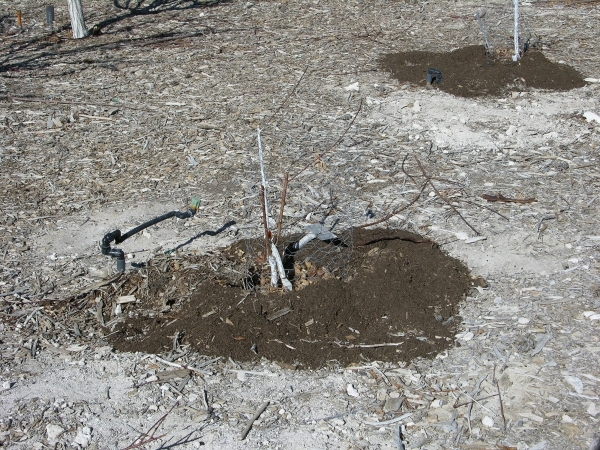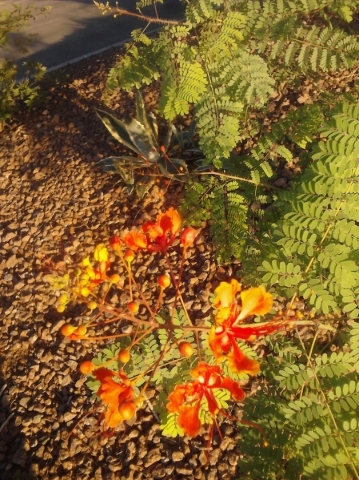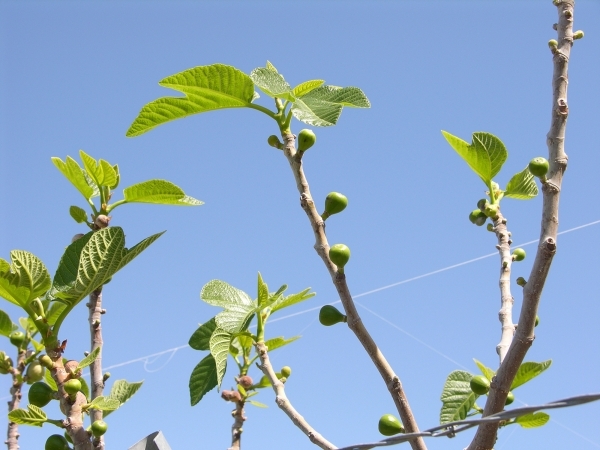April is best time in desert to deploy pheromone traps
Q: I was reading about your use of pheromone traps for insect control in fruit trees. Which traps do you use, and when do you put them out?
A: I have used pheromone traps to capture insect pests rather than spray for them. I didn't start using traps annually until I saw damage to the tree or damage to the fruit. I don't believe in spraying trees unless you have to.
Backyard fruit tree growers are lucky here because we do not have many commercial fruit tree orchards surrounding us. If we did, we would see a lot more pests damaging our fruit trees than we do. One pest I trap includes an insect that gets into apple and pear fruit called the coddling moth. This insect pest can cause wormy apples or pears.
The second pest I trap causes wormy peaches, nectarines and occasionally apricots and almonds. This insect is called the peach twig borer.
Pheromone traps are hung in fruit trees, usually around April. The traps contain a sticky surface and a lure impregnated with a mating hormone called a pheromone. This impregnated lure releases a scent that is very seductive to the opposite sex, luring them to the sticky trap where they are caught.
Traps like these are used in large commercial orchards to assist in the applications of pesticides that kill these insects. However, if a high concentration of this mating pheromone is released among the fruit trees, the male and female insect cannot find each other.
The technique is called mating disruption. Under some circumstances, it can be a very effective way of controlling insect pests without applying pesticides.
Pheromone traps for these pests in our climate are usually deployed in April. The lures are replaced every couple of weeks, so there is a very high concentration of the pheromone released.
Check out my blog in the first week of February for more specific instructions on how to use pheromone traps. I will schedule a class on how to use them for those who are interested.
Q: What should we be doing to fruit trees right now?
A: The early blooming fruit trees have their flower buds and leaf buds swelling right now. Flowering on the early fruit trees will begin at the end of this month. You still have time to get an application of dormant oil on before flowering.
Never spray dormant oils if you see any color in the flower buds. Never spray fruit trees with dormant oil when they are blooming.
After they finish blooming and the petals have fallen from the flowers and fruit is present, dormant oils can still be applied until temperatures hit the upper 80s.
The best time to apply a fertilizer is now through February. Apply an iron chelate to the soil around the trees, preferably EDDHA iron chelate, before the end of February. Substitute applications of compost, not soil mix, in place of a fertilizer application. Fruit trees growing in our soils respond extremely well to applications of a good compost applied on the soil over their roots.
Fruit trees that are 3 years old: Apply 1 to 2 cubic feet of compost for each tree, and water it in thoroughly. Trees 4 to 6 years old: Apply 3 cubic feet of compost. Trees older than this can receive 4 to 5 cubic feet of compost. Keep all fertilizers and compost away from the trunk a distance of at least 1 foot, and water it in.
Paint the trunk and the upper surfaces of all major limbs coming from the trunk with whitewash to reduce sun damage and borer attacks. Dilute white latex paint half and half with water before applying, and it will go further and be just as effective.
Delay pruning your grapes until mid-February to avoid late freeze damage. Protection of nectarine fruit from scarring due to Western flower thrips begins with applications of the organic spray Spinosad as soon as flowers drop their petals and tiny fruit can be seen.
Q: I have a beautiful fig tree in our yard. I love the big leaves, but I hate the figs. We do not eat figs, and it makes a big mess. Our desert tortoise is the only one that eats them. Can I make it not produce the fruit?
A: Controlling the fruit on figs is going to be difficult and time-consuming. Keeping fruit trees from fruiting is a difficult job regardless of the fruit tree, but with figs, it's harder than most other fruit trees. Let me explain why.
In our climate, fig fruit is produced in two crops: one in the early summer and a second one in midsummer. It tries to fruit a third time in the fall, but our season is not long enough for a third crop to fully develop.
The first crop is produced on the branches or wood that grew last year. You can see this wood easily because it is a different color than older wood.
If a fig tree only produced fruit on this wood, then fruiting would be fairly easy to control: Cut off all of last year's growth. It wouldn't take a long time, and there would be no fruit that summer. But figs produce a second crop on wood that grows the same year the fruit is produced. This wood must be removed, too, as soon as it is produced. Pruning would have to be done twice: once in the winter to remove last year's growth and again in early summer to remove all the new growth. If you did both, you would eliminate all the fruit on a fig tree.
Q: I have a large flaming bird of paradise plant at the front of my trailer. I cut it down to about 4 feet. The former owner cut it down to almost 1½ foot. It came back last year and this year so much I cut it back twice. I noticed when some were cut nearly to the ground they did not come back well. I rarely water it either. What should I do?
A: I would not prune this plant to a 4-foot height. Pruning it this way will cause it to look odd over time. There are two ways to prune this plant. One method is to prune two or three of the largest stems within 4 to 6 inches of the soil every 2 to 4 years depending on how rapidly it grows.
The other method is to wait until the plant is overgrown, in your opinion, and cut everything back to about 4 to 6 inches above the soil surface.
Desert or Mexican bird of paradise won't grow rapidly if it receives infrequent watering. Even if you are not watering it, it must be getting water from somewhere if it is growing that rapidly. This plant grows quickly when lots of water is present. Water it weekly in the early spring to encourage flowering. Other times of the year it can be watered monthly.
Pruning is done late in the winter or early spring when the majority of the coldest weather has passed. After pruning, fertilize lightly and irrigate to help push new growth and encourage flowering. Use a rose or fruit tree fertilizer.
Q: I've had an apricot tree for four years. The first year, it got fruit. Ever since it hasn't. What do I need to do? It's a beautiful tree.
A: Obviously, something has happened since you planted it. Make sure your fruit tree was planted in soil amended with compost and staked solidly immediately after it was planted. Paint the trunk and lower limbs with whitewash to protect it from sun damage, which is frequently followed by borer attacks.
Make the whitewash with a 50/50 dilution of white latex paint and water. Don't be afraid to paint the trunk and main limbs with this concoction.
Irrigate with enough water, and apply it often enough, to push the new growth needed for flower and fruit development. This would be weekly starting the first week of February. In the second year, the amount of water applied should be doubled.
The key to adequate growth for flower and fruit production is water and fertilizer. It is normal to see at least 18 inches of new growth or more on a young tree.
Prune carefully. Cut back excessively long growth, over 18 to 24 inches, to encourage the development of fruiting spurs. Fruiting spurs on apricot are short shoots that extend perpendicular from the main branches and support flowers and fruiting.
Watch for late freezing weather. If there is a light frost during bloom, or slightly after bloom, it is possible to lose the crop for that year. Be careful not to cut off all the little short shoots that are perpendicular to the limbs. If you remove them, then you will eliminate all of the fruit as well, permanently.
At this point, I would tell you to make sure the tree gets enough fertilizer and water. Second, if growth is excessively long, cut it back to 18 inches and leave the plant alone.
— Bob Morris is a horticulture expert living in Las Vegas and professor emeritus for the University of Nevada. Visit his blog at xtremehorticulture.blogspot.com. Send questions to Extremehort@aol.com.



























